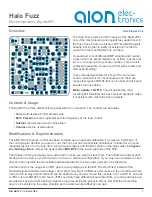
1
BIG MUFF PI / HALO FUZZ
Halo Fuzz
Electro-Harmonix Big Muff Pi
Controls & Usage
The Big Muff is a thick distortion/fuzz pedal with a ton of sustain. The controls are as follows:
•
Tone
controls allow for EQ adjustments
•
Mid / Presence
control (optional) sets the frequency of the tone control
•
Sustain
controls the amount of distortion
•
Volume
sets the overall output
Modifications & Experimentation
The AMZ Mid / Presence control has been included as an optional modification. To preserve “symmetry” of
the control layout whether you use it or not, the Tone pot has two possible orientations: middle (for a 3-knob
triangular layout) or to the side (for a 4-knob square layout with the Mid control on the other side).
To bypass
the midrange knob
, jumper the pads marked
MID BYP
in the lower-right side of the PCB.
The diodes in both gain stages have extra pads in case you want to stack them. The middle two pads of each
diode are connected, so you can fit two in a row in a stand-up configuration. If you only use one diode in each
direction then just skip the two middle pads and solder it to the two outer pads as in the silkscreen.
Another option is the usage of a JFET gain recovery stage (as in the BJF Fire Red Fuzz) instead of the
standard bipolar transistor gain stage. I don’t know how big of a difference this makes in the overall sound, but
it can be fun to play around with and can be added to any variant. To use this, include C101 and R101 and use
a JFET such as 2N5485 in Q4. Since JFETs normally have different pinouts than BJTs, an extra pad has been
provided to keep you from having to twist the legs. Assuming the pinout is D-S-G, just shift the whole thing
down so it’s still facing the same direction as the silkscreen but offset by one pad.
The Halo Fuzz project is a DIY version of the Big Muff Pi,
one of the most popular (and copied) fuzz pedals next to
the Fuzz Face. There are plenty of DIY Big Muff projects
already, but in order to justify its existence I’ve tried to
make mine the most flexible one out there.
I researched a lot of different BMP variants and created
a layout that can accommodate any of them, but the real
fun is in coming up with your own version. This circuit is
endlessly tweakable, so load up a PCB with sockets and
start experimenting!
I have included parts lists for a few of the more well-
known variants, but it’s not exhaustive and there are
many other types of BMPs that can be built on this board
besides the ones listed.
Minor update, 10/2015:
The pot positioning (and
resulting drill template) has been revised slightly to make
it consistent with most other Aion projects.
Halo Project Link
Overview


























